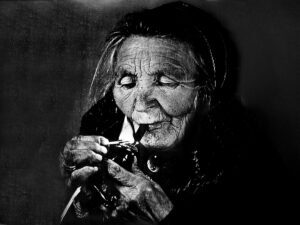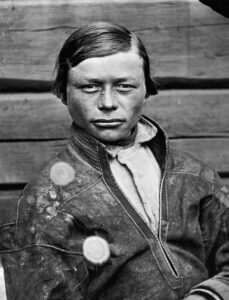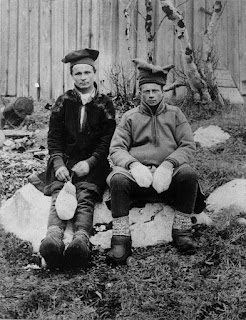Sámi Connections with Polar Expeditions
It’s been very warm here on theOlympic Peninsula in the Pacific Northwest the last week. Not compared to Phoenix,of course, but high for those of us more used to summer temperatures in the sixtiesand low seventies. The heat encourages me to continue on with polar themes.
Recently,for my travel book North Coast of the North, about Arctic Norway, I’vebeen doing some research into a handful of Sámi from Northern Norway whoaccompanied some of the famous polar explorers on expeditions to Svalbard, Greenlandand Antarctic. A good source has been the website, Polar History, sponsored by the Polar Institute and the Arctic University in Tromsø.
Along withbiographies of over two hundred men, including six Sámi, is a separate category listing twenty-eightwomen who had a connection to one or both of the poles, whether as cook, wife,hunter, scientist, or explorer. One woman appears in both categories.
 Margarthe KittiThis is Margarthe(Lango) Kitti. As a young girl from a reindeer herding family outside Tromsø, Kittiwas approached for her skill in sewing and commissioned to create theSami-style gákti, fur and skin clothing and shoes, for Roald Amundsen’s GjøaExpedition through the Northwest Passage.
Margarthe KittiThis is Margarthe(Lango) Kitti. As a young girl from a reindeer herding family outside Tromsø, Kittiwas approached for her skill in sewing and commissioned to create theSami-style gákti, fur and skin clothing and shoes, for Roald Amundsen’s GjøaExpedition through the Northwest Passage. The idea ofemploying Sámi men, known for their abilities as skiers, on expeditions to thefrozen ends of the earth seems to have originated with Adolf Erik Nordenskiöld,who participated in three geological trips to Svalbard. On one such expeditionin 1872, he purchased forty reindeer and hired four Sámi men to take care ofthem, only one of whom is named: Nils Mathisen Sara. After Nordenskiöld’ssuccessful transit of the Northeast Passage, he set his sights on Greenland. In1883, Nordenskiöld recruited two hardy Sámi men, Pava Lars Tuorda and AndersRassa, to sail with him and his team of scientists to the west coast ofGreenland and from there see if they could cross overland to the east coast.
 Pava Lars Tuorda
Pava Lars TuordaPava Lars Tuorda wasborn in the Tuorpan siida, in the mountains west of Jokkmokk, Sweden in1847. He early showed himself to be a skier of great endurance and an excellenthunter of wolves and bears, with spear and rifle. In the 1860s he was hired asa guide for Swedish geographers who were in the process of mapping areas ofNorrbotten province. In addition to bearing large loads, Tuorda was adept atfinding routes through challenging terrains. Asked for other recommendations,Tuorda suggested his neighbor Anders Rassa. The two men sailed off in the Sophiefrom Göteborg with the rest of Nordenskiöld’s team in June 1883 for the westcoast of Greenland.
One ofNordenskiöld’s theories was that he might discover a warmer center to theworld’s largest island, where trees and other vegetation could conceivablythrive in a drier climate away from the coast. But the team, burdened with amassive amount of equipment, found it difficult to navigate their sledgesacross Greenland’s glacial fissures and the deep snow that hid wet pocketsunderneath. Tuorda took the lead, but eventually Nordenskiöld decided thesledges could no longer go on. Instead, he sent Tuorda and Rassa ahead. Withtwo compasses, a barometer, and a pocket watch, they were to ski as far as theycould inland. Tuorda also took his bear spear. In the next fifty-two hours thetwo Sámi skied east 143 miles and then turned around and skied back, restingonly two hours during that time, when they were enveloped in a snowstorm andhad to dig themselves into the snow until it passed. They found no grass ortrees, only endless vistas of ice and snow.
 Per Saivo (l.) and Ole Must,1898
Per Saivo (l.) and Ole Must,1898 Anotherpair of Sámi men who participated in Arctic exploration were Ole Must and PerSaivo from Kirkenes. Thesetwo young men had their photographs taken by Elissif Wessel before they leftfor the South Pole on the British Antarctic Expedition 1898-1900, headed by theNorwegian-British leader, Carsten Borchgrevink, and with the aim of collectingscientific data, including fixing the location of magnetic south pole, and thenadvancing as far as possible towards the pole itself. The expedition’s crew,almost all Norwegian, successfully spent the winter of 1899 in twoprefabricated houses on the Antarctic mainland and managed to get by sledge to78° 50′ S., setting the “farthest south” record of the time.



